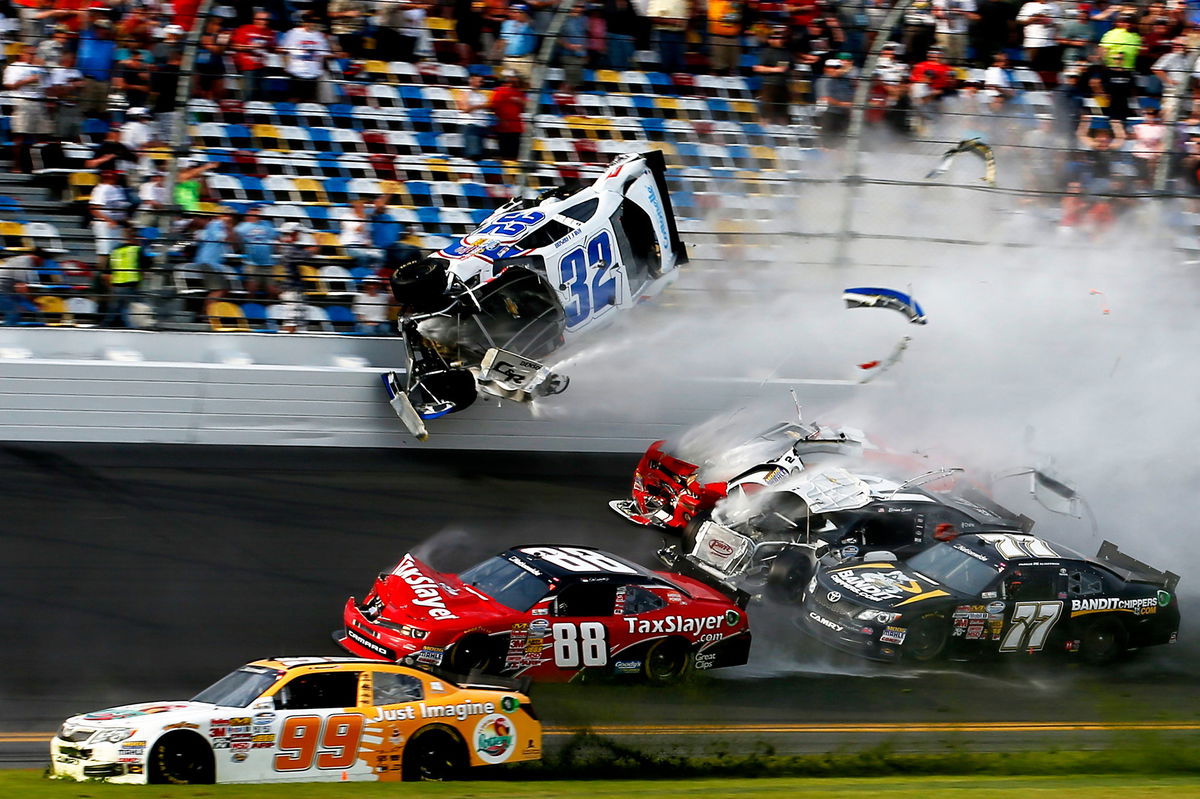

The Bass Pro Shops Night Race at Bristol Motor Speedway delivered the kind of heart-pounding finish that makes NASCAR fans live for when it comes to the sport. In the closing laps, Christopher Bell pulled off a masterclass, charging from fifth to first after a late restart, thanks to fresh right-side tires that gave him the edge.
Watch What’s Trending Now!
A viral post on X sparked a firestorm, “The fact Keselowski hit Bell that hard for the bump and run on the final corner and his car barely moved bothers me a bit tho. Thoughts?” Fans lit up the platform, pointing fingers at the Next-Gen car’s design for killing the drama of the bump-and-run, a move that’s been a Bristol staple for decades.
Brad Keselowski, never one to go down without a fight, threw everything he had into a classic bump-and-run move in the final corner, smacking Bell’s rear bumper to knock him off the line. Bell took the hit like a champ, kept his No. 20 Toyota straight, and crossed the finish line just 0.343 seconds ahead for his first Bristol points win. The intensity of that moment, 14 cautions, brutal tire wear, and a clean but fierce battle, had fans buzzing about the skill and respect on display.
ADVERTISEMENT
The fact Keselowski hit Bell that hard for the bump and run on the final corner and his car barely moved bothers me a bit tho. Thoughts? https://t.co/If5H9hnOZT
— The Daily Downforce (@dailydownforce) September 14, 2025
The race was a tire management war, with a softer right-side tire causing chaos as drivers slid and spun under cooler night conditions. Bell led just 12 laps, leaning on smart pit calls to stay in contention, while Keselowski’s 33 laps led showed his strength until the final restart’s outside lane pick cost him grip and momentum.
Bristol’s always been about chaos and contact, where the high banks and tight quarters make bump-and-runs a crowd-pleaser. Back in the day, legends like Dale Earnhardt Sr. would nudge rivals up the track or into the wall with a precision that defined short-track racing. The Next-Gen car, introduced in 2022, brought wider tires, a sturdier build, and more stability, but fans argue it has dulled the sport’s raw edge.
ADVERTISEMENT
Bell’s ability to absorb Keselowski’s hit without spinning reignited debates about whether the car’s design is robbing NASCAR of its greatest joy: the unpredictable, high-stakes battles that make races like Bristol unforgettable. The finish was a testament to Bell’s poise and Joe Gibbs Racing’s strategy, securing a Round of 16 sweep and snapping his 24-race winless streak. Keselowski’s gamble, while bold, fell short, but his clean approach earned respect.
But not everyone was thrilled.
ADVERTISEMENT
Fans vent over next-gen’s bump-and-run block
The X post about Keselowski’s bump-and-run on Bell not budging the No. 20 had fans in a tizzy, with reactions ranging from awe to outright annoyance. One fan summed it up, “kinda surprised me too. ls it the car or did C.Bell just predict that hit perfectly because the radio picked up someone saying ‘good job. Perfect’.” Bell’s composure was key, race audio caught his spotter praising the save, and replays show him holding steady after Keselowski’s square hit.
His inside lane choice on the Lap 491 restart, paired with fresh tires, let him dive low and avoid the slide-prone outside. The Next-Gen’s wider 14.5-inch tires and lower center of gravity likely helped him stay planted, but fans wonder if Bell’s anticipation or the car’s stability stole the drama.
ADVERTISEMENT
Another fan wasn’t buying it, “I agree. Next Gen killed the bump and run. You have to full-on Austin Dilon someone now to move them.” The reference to Austin Dillon’s aggressive wrecks, like his 2024 Richmond move, highlights the Next-Gen’s resilience.
Its sturdy build and wider tires make it harder to unsettle, unlike older cars that would have spun under Keselowski’s hit. Bristol’s 2025 tire wear chaos, 14 cautions from shredding right-sides, should have amplified the bump-and-run’s impact, but Bell’s car barely flinched, leaving fans feeling cheated out of a classic Bristol moment.
A different take praised the restraint, “It barely moved because he hit him square. It was a classy move. He could have hit him in the corner and spun him. 20yo Brad would have. Good racing.”
ADVERTISEMENT
Keselowski’s clean approach, hitting Bell dead-on rather than clipping a corner, kept it fair, unlike the younger, brasher Keselowski who might have spun a rival in his Penske days. The Next-Gen’s stability let Bell absorb it, but fans still saw sportsmanship in Keselowski’s measured move, even if it did not deliver the win.
One fan pointed to the tires, “That’s what four 14.5 inch wide tires will do. Narrow up the tires to 10.5 inches max and the cars won’t need more horsepower.” The Next-Gen’s wider tires, designed for grip and durability, were a double-edged sword at Bristol.
While they helped Bell hold the line, they dulled the chaos fans crave. Older cars with narrower tires, like the 2006 era, were easier to unsettle, making bump-and-runs more effective and races wilder.
ADVERTISEMENT
Finally, a nostalgic jab, “They are like if you made a cup car out of Lego blocks but then glued them together. If this was 2006, Brad would of sent him into the stands with that move.”
The Next-Gen’s tank-like build, stiffer chassis, wider stance, makes it feel “glued” compared to the twitchy Gen-4 cars of 2006, when Earnhardt or Stewart could have launched a rival skyward with a nudge. Fans miss that raw, unpredictable edge, and Bell’s ability to shrug off Keselowski’s hit only fueled their frustration with a car that has tamed NASCAR’s greatest joy.
ADVERTISEMENT
ADVERTISEMENT
ADVERTISEMENT

